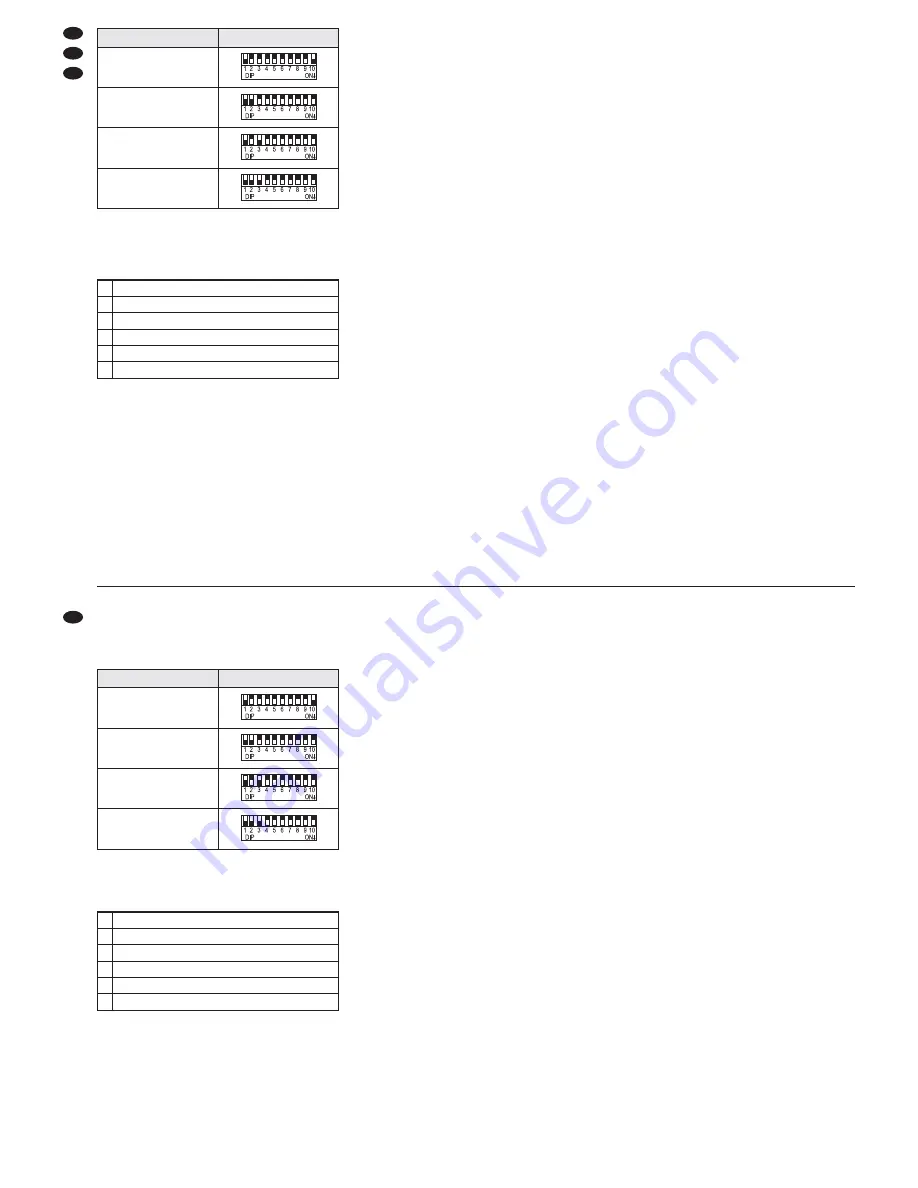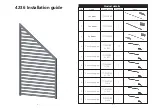
7.2.3 Blitzmuster
Die zusammengeschalteten Geräte blitzen nach
festgelegten Mustern. Sechs verschiedene Muster
sind programmiert:
1 = Gerät 1, 2 = Gerät 2, 3 = Gerät 3, 4 = Gerät 4
7.2.4 Fernbedienung LC-3 / FSC-3
Die separat erhältlichen Fernbedienungen
LC-3
(Abb. 2) und FSC-3 (Fußfernbedienung; funktioniert
wie LC-3) bieten zusätzliche Funktionen:
1) Die Fernbedienung an die Buchse ONLY FOR
REMOTE CONTROL (9) des Hauptgeräts an
-
schließen. [Am Eingang DMX IN (7) darf kein
DMX-Signal anliegen.]
2) Die Taste MODE (14) dient zur Wahl des Be
-
triebsmodus (angezeigt durch die LED neben der
Taste) und die Taste FUNCTION (13) zum Aufru-
fen einer Funktion im gewählten Modus:
Modus „Audio“
(LED leuchtet nicht):
musikgesteuertes Blitzen, die programmierten
Blitzmuster wechseln in Abhängigkeit der
Musik; wird die Taste FUNCTION gedrückt
gehalten, blitzen alle Stroboskope gleichzeitig
sehr schnell
Modus „Manual“
(LED leuchtet):
musikgesteuertes Blitzen, aus den program-
mierten Blitzmustern lässt sich mit der Taste
FUNCTION das ge wünschte Muster wählen
Modus „Auto“
(LED blinkt):
automatischer Ablauf der programmierten
Blitzmuster; mit der Taste FUNCTION lässt
sich zwischen drei Blitzfrequenzen (Taste kurz
drücken) und drei Blitzhelligkeiten (Taste län-
ger ge drückt halten) wechseln
3) Mit der Taste STAND BY (12) lassen sich alle
Ge räte in den
Ruhemodus (Lampe aus)
schal-
ten. Im Ruhemodus leuchtet die LED neben der
Taste. Zum Deaktivieren des Ruhemodus die
Taste erneut drücken.
8
Betrieb mit DMX-Lichtsteuergerät
Die Blitzfrequenz und die Blitzhelligkeit des Strobos -
kops lassen sich über ein Lichtsteuergerät mit
DMX512-Protokoll steuern
→
siehe Kapitel 8.1 und
8.2 sowie die Tabelle in Kapitel 10.1.
Das Stroboskop lässt sich auch über den
Controller STROBE-4C von „img Stage Line“ bedie-
nen, ein Mini-Steuerpult, mit dem sich bis zu vier
Geräte STROBE-1500DX steuern lassen. Genaue-
res zur Bedienung entnehmen Sie bitte der Anleitung
zum STROBE-4C.
8.1 Anschluss
Als DMX-Schnittstelle besitzt das Stroboskop 3-po -
lige XLR-Anschlüsse mit folgender Kontaktbelegung:
1 = Masse, 2 = DMX-, 3 = DMX+
Zum Anschluss sollten spezielle Kabel für hohen Da -
tenfluss verwendet werden. Normale abge schirmte
Mikrofonkabel mit einem Leitungsquerschnitt von
mindestens 2 × 0,22 mm
2
und möglichst geringer
Kapazität sind nur bei einer Gesamtkabellänge bis
100 m zu empfehlen. Bei Leitungslängen ab 150 m
wird das Zwischen
schalten eines DMX-Aufholver-
stärkers (z. B. SR-103DMX von „img Stage Line“)
empfohlen.
1) Den DMX-Eingang (7) mit dem DMX-Ausgang
des Lichtsteuergerätes verbinden.
2) Den DMX-Ausgang (8) mit dem DMX-Eingang
des nächsten Lichteffektgerätes verbinden. Des-
sen Ausgang wieder mit dem Eingang des nach-
folgenden Gerätes verbinden usw., bis alle Licht-
effektgeräte in einer Kette angeschlossen sind.
3) Den DMX-Ausgang des letzten DMX-Geräts der
Kette mit einem 120-Ω-Widerstand (> 0,3 W) ab -
schlie ßen: An die Pins 2 und 3 eines XLR-Ste-
ckers den Widerstand anlöten und den Ste cker in
den DMX-Ausgang stecken oder einen entspre-
chenden Abschlussstecker (z. B. DLT-123 von
„img Stage Line“) verwenden.
8.2 DMX-Startadresse einstellen
Über die Schalter Nr. 1 – 9 des DIP-Schalter-Blocks
(10) die Startadres se für den 1. Kanal (Blitzfrequenz)
einstellen. Der 2. Kanal (Blitzhelligkeit) ist dann auto-
matisch der folgenden Adresse zugeordnet. Für die
nächsten Licht effektgeräte in der Kette können die
darauffolgenden freien Adressen verwendet werden.
Beispiel: mögliche Adressenvergabe bei Einsatz von vier Gerä-
ten STROBE-1500DX
Gerät 1: Startadresse 1 für Kanal 1, Adresse 2 für Kanal 2
Gerät 2: Startadresse 3 für Kanal 1, Adresse 4 für Kanal 2
Gerät 3: Startadresse 5 für Kanal 1, Adresse 6 für Kanal 2
Gerät 4: Startadresse 7 für Kanal 1, Adresse 8 für Kanal 2
Die Startadresse wird als Binärzahl eingestellt. Sie
ergibt sich durch die Addition der Stellenwerte
(Beschriftung „1 ... 256“ unter dem DIP-Schalter-
Block) derjenigen DIP-Schalter, die auf „ON“ gestellt
sind, z. B. für die Startadressen 1, 3, 5 und 7 :
1
1234 Full on
2
1-2-3-4 — 4-3-2-1
3
1-2-3-4-4-3-2-1
4
12-34 — 23-14
5
1-12-123-1234-123-12-1-Stopp — 4-43-432-4321-432-43-4-Stopp
6
1-2-1-2-3-4-3-4 — 4-1-4-1-3-2-3-2
Gerät
Einstellungen
Gerät 1
(Hauptgerät)
Gerät 2
(1. Nebengerät)
Gerät 3
(2. Nebengerät)
Gerät 4
(3. Nebengerät)
7.2.2 Adjustments of the DIP switches
The DIP switches (10) are used to assign different
addresses to the units and to set them to master or
slave mode. Set the switches as follows:
7.2.3 Flash patterns
The interconnected units will flash according to de -
fined patterns. Six patterns have been programmed:
1 = unit 1, 2 = unit 2, 3 = unit 3, 4 = unit 4
7.2.4 Remote controls LC-3 / FSC-3
The remote controls LC-3 (fig. 2) and FSC-3 (foot
remote control; same operation as LC-3) to be
ordered separately offer additional functions:
1) Connect the remote control to the jack ONLY
FOR REMOTE CONTROL (9) of the master unit.
[There must be no DMX signal at the input DMX
IN (7).]
2) The button MODE (14) is used to select the op er -
ating mode (indicated by the LED next to the but-
ton); the button FUNCTION (13) is used to call a
function in the mode selected:
Mode “Audio”
(LED off):
music-controlled flashing, the programmed
flash patterns will change as a function of
the music; if the button FUNCTION is kept
pressed, all stroboscopes will flash rapidly at
the same time
Mode “Manual”
(LED on)
music-controlled flashing, the button
FUNCTION is used to select the desired
pattern from the programmed flash patterns
Mode “Auto”
(LED flashing)
automatic sequence of the programmed flash
patterns; the button FUNCTION is used to
switch over between three flash rates (press
button shortly) and three flash intensities
(keep the button pressed for a longer time)
3) With the button STAND BY (12), all units can be
switched to
sleep mode (lamp off)
. In the sleep
mode, the LED next to the button will be on. To
deactivate the sleep mode, press the button once
again.
8
Operation with a DMX Light Controller
The flash rate and the flash intensity of the strobo-
scope can be controlled via a light controller with
DMX512 protocol
→
see chapters 8.1 + 8.2 and the
table in chapter 10.1.
The stroboscope can also be controlled via the
controller STROBE-4C by “img Stage Line”, a minia-
ture control panel allowing to control up to four
STROBE-1500DX units. Details concerning opera-
tion can be found in the STROBE-4C manual.
8.1 Connection
As a DMX interface, the stroboscope is provided with
3-pole XLR jacks of the following pin configuration:
1 = ground, 2 = DMX-, 3 = DMX+
For connection, special cables for high data flow
should be used. Microphone cables with standard
screening and a minimum cross section of 2 ×
0.22 mm
2
and with a capacity as low as possible can
only be recommended for a total cable length of up
to 100 m. For cable lengths exceeding 150 m it is
recommended to insert a DMX level matching ampli-
fier (e. g. SR-103DMX by “img Stage Line”).
1) Connect the DMX input (7) to the DMX output of
the light controller.
2) Connect the DMX output (8) to the DMX input of
the following light effect unit; connect its output
again to the input of the following unit, etc. until all
light effect units have been connected in a chain.
3) Terminate the DMX output of the last DMX unit in
the chain with a 120 Ω resistor (> 0.3 W): Solder
the resistor to the pins 2 and 3 of an XLR plug and
connect the plug to the DMX output or use a cor-
responding terminating plug (e. g. DLT-123 by
“img Stage Line”).
8.2 Adjusting the DMX start address
Adjust the start address for the first channel (flash
rate) via the switches 1 to 9 of the DIP switch block
(10). The second channel (flash intensity) is auto-
matically assigned to the following address. For the
following light effect units in the chain, the subse-
quent free addresses can be used.
Example for address assignment when using four STROBE-
1500DX units
Unit 1: start address 1 for channel 1, address 2 for channel 2
Unit 2: start address 3 for channel 1, address 4 for channel 2
Unit 3: start address 5 for channel 1, address 6 for channel 2
Unit 4: start address 7 for channel 1, address 8 for channel 2
The start address is adjusted as a binary number. It
will result by adding the place values (marking
“1 … 256” below the DIP switch block) of the DIP
switches set to “ON”, e. g. for the start addresses 1,
3, 5, and 7:
1
1234 Full on
2
1-2-3-4 — 4-3-2-1
3
1-2-3-4-4-3-2-1
4
12-34 — 23-14
5
1-12-123-1234-123-12-1-Stopp — 4-43-432-4321-432-43-4-Stop
6
1-2-1-2-3-4-3-4 — 4-1-4-1-3-2-3-2
Unit
Adjustments
Unit 1
(master unit)
Unit 2
(first slave unit)
Unit 3
(second slave unit)
Unit 4
(third slave unit)
D
A
CH
6
GB







































